Everything on this page & many other contributions
throughout the site, kindly donated by Paul Holroyd of
Vintage Carriages Trust.
The trust owns and operates
the Museum of Rail
Travel at Ingrow, near Keighley,
West Yorkshire BD21 5AX website - www.vintagecarriagestrust.org
See also : Vintage Carriages Trust
Transperience
Keighley & Worth valley Railway
|
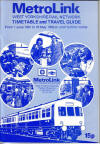 Metrolink
time table 1981 Metrolink
time table 1981
In 1954, the Leeds/Bradford area of the West Riding of Yorkshire
was chosen
by British Railways as a pilot to test Diesel Multiple Units.
In the 1980s
history repeated itself when the area became the testbed for a new
generation of DMUs. |
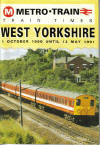 Metro
Time table 1990 Metro
Time table 1990
The Class 307 units were built in 1956 - underframes at Ashford, and
bodies at Eastleigh - for the London Liverpool Street to Southend
Victoria route, which was electrified at 1,500 volts d.c. During 1960-62
they were converted at Stratford to operate at 25 kV a.c. Originally,
they were non-gangwayed, but from 1981 they were refurbished with
gangway connections within each unit, and the compartments were
converted to open saloons. The first class section was moved from the
intermediate trailer to a new position behind one of the driving cabs.
Their last run on the Southend Victoria route came on 30 June 1990, but
six of the units were transferred to work the recently electrified Leeds
to Doncaster route, with unit 307 122 working a press trip from Leeds to
Wakefield Westgate on 4 July 1990 |
KWVR Waggon und Maschinenbau railbus
 Five
railbuses were built in 1958 by Waggon und Maschinenbau of Donauworth,
West Germany. They were used on branch lines in Essex and East Anglia
including the Witham - Braintree and Marks Tey - Sudbury routes. E 79964
ran for a short time in the North East on the Haltwhistle-Alston branch
. In July 1966 it was transferred to Derbyshire to work the Buxton -
Millers Dale branch. Both E 79962 and E 79964 were moved in 1967 to the
Keighley & Worth Valley Railway, in readiness for the reopening of the
Keighley - Oxenhope branch on 29 June 1968. Only one of this batch of
railbuses succumbed to the scrapman. Five
railbuses were built in 1958 by Waggon und Maschinenbau of Donauworth,
West Germany. They were used on branch lines in Essex and East Anglia
including the Witham - Braintree and Marks Tey - Sudbury routes. E 79964
ran for a short time in the North East on the Haltwhistle-Alston branch
. In July 1966 it was transferred to Derbyshire to work the Buxton -
Millers Dale branch. Both E 79962 and E 79964 were moved in 1967 to the
Keighley & Worth Valley Railway, in readiness for the reopening of the
Keighley - Oxenhope branch on 29 June 1968. Only one of this batch of
railbuses succumbed to the scrapman. |
 Class
101 51436 at Bradford
Interchange 15 June 1981 Class
101 51436 at Bradford
Interchange 15 June 1981
Numerically the largest fleet of DMUs, with 637 vehicles being built,
the examples built by Metropolitan-Cammell of Birmingham were introduced
from October 1956. Some even included a buffet car. In 1959 DMUs of this
type took over the local services from Mirfield to Low Moor via
Cleckheaton Central.
51436 was photographed at Bradford Interchange on 15 June 1981. |
 Class 101 Metropolitan-Cammell
DMU 2nd May 2009 Class 101 Metropolitan-Cammell
DMU 2nd May 2009
Newly repainted in British
Railways green, Driving Motor Composite Lavatory
51803, built in 1959,
stands at the Ingrow Railway Centre on 02 May 2009. |
Class 104 at keighley 28 April
1984
 The class 104 was produced by the Birmingham Railway Carriage & Wagon
Company of Smethwick from April 1957 and featured the standard Blue Square
multiple unit couplings.
In 1984, the Settle to Carlisle railway line was threatened with closure,
and the line was visited by many railtours. A private charter train for
Northolt Model Railway Club of West London is seen at Keighley, after the
tour participants had travelled on the Keighley & Worth Valley Railway in
Metropolitan Railway carriages 427 and 465 owned by the Vintage Carriages
Trust. The class 104 was produced by the Birmingham Railway Carriage & Wagon
Company of Smethwick from April 1957 and featured the standard Blue Square
multiple unit couplings.
In 1984, the Settle to Carlisle railway line was threatened with closure,
and the line was visited by many railtours. A private charter train for
Northolt Model Railway Club of West London is seen at Keighley, after the
tour participants had travelled on the Keighley & Worth Valley Railway in
Metropolitan Railway carriages 427 and 465 owned by the Vintage Carriages
Trust.
Note the absence of overhead electrification. |
 Class
108 53622 at Leeds on 27 September 1983 Class
108 53622 at Leeds on 27 September 1983
The class 108 was built at Derby from May 1958. 333 vehicles were built,
of which 210 were powered.
A number have survived into preservation. |
Class 110
51826 at Leeds on 27 September 1983.
 The class 110 was built from June 1961 by the Birmingham Railway Carriage &
Wagon Company of Smethwick specifically The class 110 was built from June 1961 by the Birmingham Railway Carriage &
Wagon Company of Smethwick specifically
for the ex-Lancashire & Yorkshire
Railway Calder Valley route from Leeds via Halifax and Todmorden to
Manchester Victoria.
Fortunately, some of this class have been preserved. See the Railway
heritage register database at -
http://www.vintagecarriagestrust.org/surveystatus.asp |
 Class
123 Inter-City unit 52092 at Leeds on 27 September 1983 Class
123 Inter-City unit 52092 at Leeds on 27 September 1983
Despite the Trans-Pennine branding, the class 123
Inter-City units built at Swindon from February 1963 were not intended
for use in the West Yorkshire area, being originally based at Cardiff,
then subsequently transferred to Reading. They migrated north to Hull
Botanic Gardens depot in 1977, with the last survivors being withdrawn
in May 1984. |
Class 124 Trans-Pennine units at
Carnforth
 The
attractively-styled class 124 Trans-Pennine units were built at Swindon
from July 1960, specifically for the route via Standedge tunnel, and
originally included buffet cars.
They were regularly seen on the Leeds New Line, travelling through the
remains of Cleckheaton Spen, Liversedge Spen and Heckmondwike Spen
stations. The last examples were withdrawn in 1984, and unfortunately
none were preserved. The
attractively-styled class 124 Trans-Pennine units were built at Swindon
from July 1960, specifically for the route via Standedge tunnel, and
originally included buffet cars.
They were regularly seen on the Leeds New Line, travelling through the
remains of Cleckheaton Spen, Liversedge Spen and Heckmondwike Spen
stations. The last examples were withdrawn in 1984, and unfortunately
none were preserved.
51962 was actually photographed at Carnforth,
Lancashire on 26 June 1982.
Carnforth achieved lasting fame for its role in the film Brief
Encounter. |
LEV 1 Crossflatts 16-07-83 :
Malcolm W Clark website -
www.vintagecarriagestrust.org
 The
bodyshell of LEV 1 was built by Leyland at Workington in December 1977,
and mounted onto a four-wheel railway underframe at Derby in January
1978. Originally unpowered, a Leyland engine was fitted in 1979. LEV 1
visited the U.S.A. during December 1979 - January 1980. In October 1980
it began a two-month trial on the Ipswich - Lowestoft route. It is seen
at Crossflatts, heading towards Keighley on 16 July 1983 The
bodyshell of LEV 1 was built by Leyland at Workington in December 1977,
and mounted onto a four-wheel railway underframe at Derby in January
1978. Originally unpowered, a Leyland engine was fitted in 1979. LEV 1
visited the U.S.A. during December 1979 - January 1980. In October 1980
it began a two-month trial on the Ipswich - Lowestoft route. It is seen
at Crossflatts, heading towards Keighley on 16 July 1983 |
 LEV
1 Keighley 16-07-83 : Malcolm W Clark LEV
1 Keighley 16-07-83 : Malcolm W Clark
LEV 1 visited the Keighley & Worth Valley Railway on 16 July 1983, where
it is seen alongside Waggon und Maschinenbau railbus 799644. In 1956
Derby-built DMUs departed from Platform 3 of Keighley station on
driver-training duties along the Keighley-Queensbury route, which had
lost its passenger services in May 1955 |
 LEV
1 Keighley 16-07-83 : Malcolm W Clark LEV
1 Keighley 16-07-83 : Malcolm W Clark
LEV 1 leaves Keighley on 16 July 1983. Happily, LEV 1 has survived into
preservation. See
http://www.vintagecarriagestrust.org/se/CarriageInfo.asp?Ref=2199
|
 LEV
1 Damems 16-07-83 : Malcolm W Clark LEV
1 Damems 16-07-83 : Malcolm W Clark
LEV 1 at Damems on the Keighley & Worth Valley Railway.
Damems has featured as Grimpen in The Hound of the Baskervilles and
Ormston in Born and Bred |
Class 140 units at Leeds & Bradford
15 June 1981
 The
solitary Class 140 prototype was basically a Leyland National bus body,
built at Workington, mounted at Derby onto a railway chassis. The bodies
were delivered by road to Derby in September 1980, and the complete unit
began trial running in February 1981, entering passenger service in June
1981. Happily, the class 140 has survived into preservation, see The
solitary Class 140 prototype was basically a Leyland National bus body,
built at Workington, mounted at Derby onto a railway chassis. The bodies
were delivered by road to Derby in September 1980, and the complete unit
began trial running in February 1981, entering passenger service in June
1981. Happily, the class 140 has survived into preservation, see
http://www.vintagecarriagestrust.org/se/CarriageInfo.asp?Ref=3199 |
   Lightweight
Railbus L.E.V Lightweight
Railbus L.E.V
In May 1982 British Rail Research & Development Division published this
brochure
to promote lightweight railbus vehicles. |
Class 141 units at Harrogate
 The
class 141 was a development of the earlier railbus prototypes which had
been built between 1977 and 1980. The first of the twenty units was
officially handed over at Derby on 22 September 1983. The earliest units
were in Barrow Corporation blue and grey, soon receiving West Yorkshire
PTE verona green and buttermilk. Internally, the units had low-backed
bus-type seating, whilst the doors were of the four-piece folding bus
type, rather than the railway-type plug doors used on the class 140. The
class 141 was a development of the earlier railbus prototypes which had
been built between 1977 and 1980. The first of the twenty units was
officially handed over at Derby on 22 September 1983. The earliest units
were in Barrow Corporation blue and grey, soon receiving West Yorkshire
PTE verona green and buttermilk. Internally, the units had low-backed
bus-type seating, whilst the doors were of the four-piece folding bus
type, rather than the railway-type plug doors used on the class 140. |
 Class
141 units at York Class
141 units at York
From 1988, the class 141 units began to be rebuilt at the Andrew
Barclay works in Kilmarnock, where they were fitted with new couplings
to make them compatible with the later class 142 and 144 DMUs.
At the
same time, they began to be outshopped in the new Metro red and cram
livery. |
Class
141 units at Leeds
 Happliy,
4 units have survived in preservation. See Happliy,
4 units have survived in preservation. See
http://www.vintagecarriagestrust.org/se/CarriageInfo.asp?Ref=4109
http://www.vintagecarriagestrust.org/se/CarriageInfo.asp?Ref=3865
http://www.vintagecarriagestrust.org/se/CarriageInfo.asp?Ref=4111
http://www.vintagecarriagestrust.org/se/CarriageInfo.asp?Ref=4074
http://www.vintagecarriagestrust.org/se/CarriageInfo.asp?Ref=4110
http://www.vintagecarriagestrust.org/se/CarriageInfo.asp?Ref=3866
http://www.vintagecarriagestrust.org/se/CarriageInfo.asp?Ref=4112
http://www.vintagecarriagestrust.org/se/CarriageInfo.asp?Ref=4073 |
Prototype Railbus RB 004
 RB
004 was built in early 1984. The railbus features 3 doors per side
(half-width at each end, and full-width in the centre), and has
centrally placed driving cabs at each end of the unit. The vehicle was
tested on BR's Mickleover test track in June 1984, before being shipped
to the U.S.A., where it entered service in July 1984 on the Old Colonial
Railroad in Newport on a two-month trial period. The railbus
subsequently toured the USA, visiting Connecticut, Long Island,
Washington, alabama, New Orleans and Cleveland, Ohio, before crossing
thev border into Canada and returning to Derby works by 1986. The
railbus was then moved to the ABB works at York for use as a static
office, before moving by road in August 1994 to Embsay.
For further information , see the February 1988 issue of Motive Power
Monthly and Y.D.R. News issue 57 RB
004 was built in early 1984. The railbus features 3 doors per side
(half-width at each end, and full-width in the centre), and has
centrally placed driving cabs at each end of the unit. The vehicle was
tested on BR's Mickleover test track in June 1984, before being shipped
to the U.S.A., where it entered service in July 1984 on the Old Colonial
Railroad in Newport on a two-month trial period. The railbus
subsequently toured the USA, visiting Connecticut, Long Island,
Washington, alabama, New Orleans and Cleveland, Ohio, before crossing
thev border into Canada and returning to Derby works by 1986. The
railbus was then moved to the ABB works at York for use as a static
office, before moving by road in August 1994 to Embsay.
For further information , see the February 1988 issue of Motive Power
Monthly and Y.D.R. News issue 57
The railbus left Embsay circa 2004, but happily is still preserved,
see
http://www.vintagecarriagestrust.org/se/CarriageInfo.asp?Ref=2398
|
 Class
141 railbus and a double decker bus. Class
141 railbus and a double decker bus.
In 1985 Metro published this book which featured an artist's impression of a
class 141 railbus and a double decker bus. |
Class 142 at Keighley
 The
class 142 was a further development, with a wider body and a new design
of coupling which allowed the units to operate with classes
143,144,150,155 and 156. Externally, the doors were repositioned. The
first units entered service in Merseyside on 30 September 1985, and the
units were marketed as Pacers by the Regional Railways sector of British
Railways. 13 units were painted in chocolate and cream for use on branch
lines in Cornwall, where they were marketed as Skippers. However, the
Cornish Skippers migrated north after a relatively short period. Photo's
taken at Keighley, before the Aire Valley route was electrified. The
class 142 was a further development, with a wider body and a new design
of coupling which allowed the units to operate with classes
143,144,150,155 and 156. Externally, the doors were repositioned. The
first units entered service in Merseyside on 30 September 1985, and the
units were marketed as Pacers by the Regional Railways sector of British
Railways. 13 units were painted in chocolate and cream for use on branch
lines in Cornwall, where they were marketed as Skippers. However, the
Cornish Skippers migrated north after a relatively short period. Photo's
taken at Keighley, before the Aire Valley route was electrified. |
Class 144 units at Keighley &
Shipley
 The
class 144 features a body built by Walter Alexander of Falkirk, mounted
onto an underframe built by British Rail Engineering Ltd at Derby. The
class 144 features a body built by Walter Alexander of Falkirk, mounted
onto an underframe built by British Rail Engineering Ltd at Derby.
The interior of a class 144, as originally built with low-backed
bus-type seating. The units have now all been refurbished with
high-backed seats.
The last of the two-car units, 144 013 at platform 3 of Shipley station.
Units 014 - 023 were built with non-driving powered centre cars, making
them the only 3-car railbus units in the entire country. |
 Class
144 DMU at Skipton (October 94) Class
144 DMU at Skipton (October 94)
Alexander Class 144 DMU in Regional Railways livery at Skipton, October
1994 |
 Class
144 DMU at Skipton (October 94) Class
144 DMU at Skipton (October 94)
Alexander Class 144 DMU at Skipton, October 1994. Note the maginifcently
restored platform canopies. |
 Class
144 DMU at Skipton (October 94) Class
144 DMU at Skipton (October 94)
Alexander Class 144 DMU at Skipton, October 1994. View taken looking
south towards Cononley. |
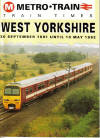 Class
321/9 electric multiple units Class
321/9 electric multiple units
Three Class 321/9 electric multiple units were built at York by BREL in 1991
for the Leeds - Doncaster service.
In August 2006 work started on
refurbishing the units at Hunslet - Barclay in Kilmarnock.
Unit 321 902 was
released from works on 26 October 2006.
Internally, the unit has been fitted
with CCTV and new tip-up seating in the wheelchair area.
The familiar Metro
red and cream has given way to a new livery of lilac, grey and red. |
|
 Class 150/1 Class 150/1
British Rail Engineering Ltd built the Class
150/1 units at York in 1985-86.
This example in Northern Rail livery was
photographed at York on 10 May 2008
|
|
Class 153
 Originally built by Leyland Bus
at Workington in 1987-88 as two-car Class 155 units, these carriages were
converted in 1991-92 by Hunslet-Barclay at Kilmarnock into single car Class
153 units. The new driving cab at the former inner end is noticeably
smaller than the original driving cab, and the new headlights are in a
different position. An article describing the conversion from Class 155 to
Class 153 appeared in the April 1992 issue of “Modern Railways”.
Photographed at York on 22 December 2007, this example is in First North
western livery. Originally built by Leyland Bus
at Workington in 1987-88 as two-car Class 155 units, these carriages were
converted in 1991-92 by Hunslet-Barclay at Kilmarnock into single car Class
153 units. The new driving cab at the former inner end is noticeably
smaller than the original driving cab, and the new headlights are in a
different position. An article describing the conversion from Class 155 to
Class 153 appeared in the April 1992 issue of “Modern Railways”.
Photographed at York on 22 December 2007, this example is in First North
western livery.
|
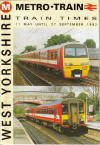 Class
155 Class
155
The Class 155 (lower photo) was a further development of the Leyland
National bus body,
but this time mounted on conventional bogies to give a
much smoother ride than the four-wheeled railbuses.
The Class 155 units were built by Leyland Bus at Workington in 1987-88.
Features on the the Class 155 units appeared in the July 1987 issue of
"Motive Power Monthly"
and the November 1987 issue of "Modern Railways"
|
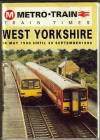 Class
155 Class
155
From 2006, the class 155 units began to lose their Metro red and cream
livery in favour of Northern Rail's new lilac colour scheme |
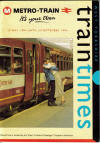 Class
155 doors Class
155 doors
Unlike the class 150 Sprinter and 156 Super Sprinter units which feature doors which slide into the body of the carriage,
the class 155
features single leaf plug doors which nestle on the outside of the carriage
when open. |
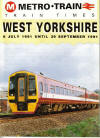 Class
158 Class
158
Metro wished to obtain a second batch of Class 155 diesel units, but Leyland
Bus declined to tender,
leading Metro to obtain Class 158/9 diesel units
built at Derby.
The first ever class 158 unit, 158 701 was handed over by BREL in
October 1989.
The first two Metro liveried units, 158 901 and 902, were offically
handed over to Metro on 22 March 1991. |
 Class
158 Class
158
Class 158, built at Derby |
 Class
158 York (06-10-07) Class
158 York (06-10-07)
Class 158 diesel multiple unit, named after cricketing legend Fred
Trueman, at York on 06 October 2007 |
|
 Class 158
York (22-11-07) Class 158
York (22-11-07)
Class 158 unit in the
now-defunct Central Trains livery. Photographed on 22 December 2007 at York.
|
Class 308 EMUs
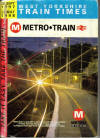 In February 1992 a formal ceremony took place at Leeds to commemorate the
start of work to electrify the routes between Leeds and Skipton, Ilkley and
Bradford Forster Square. Ceremonies took place on 30 September 1995 at
Leeds, Skipton and Bradford Foster Square to mark the completion of the
project. Originally, it had been hoped to use brand new class 323 electric
multiple units which were to have been built in Leeds by Hunslet, but the
uncertainties brought about by privatisation forced a rethink. When electric
services commenced in the Aire Valley, they used Class 308 EMUs which had
been built in 1961 at York for use on the services from Clacton on Sea and
Southend on Sea to London Liverpool Street. Originally non-gangwayed, they
were refurbished in 1985-86 with gangway connections within the units. They
were subsequently used on the Shoeburyness to London Fenchurch Street route,
then in 1993-94 they were transferred to work services in the Birmingham
area, before moving to West Yorkshire. In February 1992 a formal ceremony took place at Leeds to commemorate the
start of work to electrify the routes between Leeds and Skipton, Ilkley and
Bradford Forster Square. Ceremonies took place on 30 September 1995 at
Leeds, Skipton and Bradford Foster Square to mark the completion of the
project. Originally, it had been hoped to use brand new class 323 electric
multiple units which were to have been built in Leeds by Hunslet, but the
uncertainties brought about by privatisation forced a rethink. When electric
services commenced in the Aire Valley, they used Class 308 EMUs which had
been built in 1961 at York for use on the services from Clacton on Sea and
Southend on Sea to London Liverpool Street. Originally non-gangwayed, they
were refurbished in 1985-86 with gangway connections within the units. They
were subsequently used on the Shoeburyness to London Fenchurch Street route,
then in 1993-94 they were transferred to work services in the Birmingham
area, before moving to West Yorkshire. |
 Class 308 EMUs Class 308 EMUs
Class 308 leaflet. |
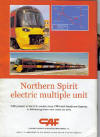 Class
333 Class
333
The class 333 units were built during 2000 - 2001 in Zaragoza, Spain by
CAF for owners Angel Trains. Initially, they were built as 3-car units,
but subsequently 8 units were strengthened to 4-cars in 2002, with a
further batch of trailers being constructed in 2003.
A feature on these EMUs appeared in the July 2000 edition of Modern Railways.
When
originally built, the franchise for Aire Valley services was operated by
Northern Spirit,
who gave way to Arriva Trains Northern, who in turn
gave way to Northern Rail Ltd (a joint venture of Serco and Netherlands
Railways). |